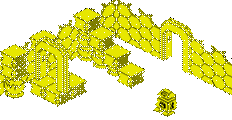Commodore PCs
Vital Statistics
Introduced
1984 |
|
![]()
What's it like today?
|
Commodore produced computers for business throughout the 80's but these met with little success, and with the rise of the IBM PC and the massive cloning industry that derived from it, Commodore first entered the IBM PC-clone market in 1987.
The PC1, launched in 1984, was a direct clone of the original IBM PC running an Intel 8088 at 4.77 MHz and a single 5.25" low density floppy drive (360K). It was not expandable internally, and had a choice of either Hercules monochrome or 4-colour CGA (Colour Graphics Adapter) graphics capability. It came supplied with MS-DOS 3.1 and GW-BASIC.
The PC5, launched in 1984, is a rarity having sold in very limited numbers (possibly only in Australia and New Zealand). It was the same as the PC1 in terms of performance, but came with expansion capabilities in the form of a RAM upgrade option from 512K to 640K, 8087 math coprocessor option, and 5 x 8-bit expansion slots. It came with a monochrome text-only display card, and a single 5.25" low density floppy drive (360K), although a second drive was an option.
Soon after, Commodore duplicated the IBM PC-XT with its PC10, which boosted the clock to 10 MHz. It came with 640K of RAM and the much better graphics option of EGA (Enhanced Graphics Adapter) which provided 16 colours from a palette of 32,768. The PC10 could be purchased with either one or two floppy drives. Commodore also shipped the PC10 under the brand name of "Colt" in the USA. A hard disk derivative of the PC10 was made available in 1988 called the PC20 which came with a 20Mb internal hard disk.
 Commodore's first IBM PC-AT compatible computer was the PC30, released in 1988. This came with an Intel 80286 CPU running at 12 MHz and had an internal 20Mb hard disk.
Commodore's first IBM PC-AT compatible computer was the PC30, released in 1988. This came with an Intel 80286 CPU running at 12 MHz and had an internal 20Mb hard disk.
The PC40 was a PC-30 with from 20Mb to 80Mb hard disk options, and 1Mb of RAM. These all came with Hercules monochrome graphics, and were sometimes referred to as HD40 due to the presence of a hard disk .
Commodore made use of the Intel 80386DX chip when it was released, with their high-end offering, the PC60. Running at 25 MHz and came in a tower case, this powerhouse was also supplied with huge hard disk choices ranging from 60Mb to 200Mb. When the cut-down 80386SX CPU arrived, Commodore also released a PC50 based on this chip, which clocked at 16 MHz. These shipped with from 40Mb to 100Mb hard disks.
You may notice these PCs also had designations after their main title, for example, PC10-II or PC20-III. The Roman numeral suffix was added whenever Commodore refreshed their model range with new cases and sometimes upgraded base specifications.
In the early 1990s, Commodore also released some PC-compatible laptop computers. Designated the Cx86-LT range, there were 80286 up to i486-based computers available.
The first of these was the C286LT, which came with both floppy drive and internal hard disk drive, serial and parallel ports, 1Mb of RAM, and monochrome graphics.
The C386SX-LT was an 80386-based laptop with 5Mb of RAM and an internal hard disk drive. It also came with Windows 3.1 pre-installed.
The 486SX-LT was the last Commodore laptop released, and came with colour VGA capability and a 20Mb hard disk.
 In 2007, the Commodore brand was brought back (although under different ownership) with the announcement of the launch of a selection of gaming PCs at the CeBit show in Germany. The company, entitled "Commodore Gaming", was entering a market for many who had no knowledge of the prior company's fame.
In 2007, the Commodore brand was brought back (although under different ownership) with the announcement of the launch of a selection of gaming PCs at the CeBit show in Germany. The company, entitled "Commodore Gaming", was entering a market for many who had no knowledge of the prior company's fame.
The top-spec models were the XX and GX (£2899 and £1759 respectively). The lower-spec models released were the G and GS models (selling at £949 and £1049 respectively). Originally, the G and GS models weren't to be sold through the online store (at www.commodoregaming.com) and would only be available through Commodore Gaming's retail outlets, which are shortly to open in the UK, Germany, France and the Benelux.
By 2010, sales had fallen sharply in the price-conscious PC gaming market and Commodore Gaming stopped their new PC line, deciding instead to market Commodore 64 games that could be played on mobile devices and home consoles, such as the Apple iPhone and Nintendo Wii.











